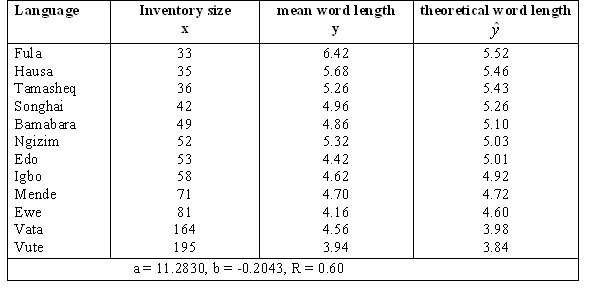Difference between revisions of "Word length and phoneme inventory"
| (One intermediate revision by one other user not shown) | |||
| Line 23: | Line 23: | ||
'''Example'''. Some African languages (Nettle 1998) | '''Example'''. Some African languages (Nettle 1998) | ||
| + | <div align="center">[[Image:Tabelle11_WLaPI.jpg]]</div> | ||
| − | <div align="center">[[Image: | + | <div align="center">[[Image:Grafik1_WLaPI.jpg]]</div> |
Inspite of a very good F-test the result is not satisfactory. Further testing using other languages with smaller inventories is necessary, and as soon as possible the consideration of the other factors which here were considered constant. | Inspite of a very good F-test the result is not satisfactory. Further testing using other languages with smaller inventories is necessary, and as soon as possible the consideration of the other factors which here were considered constant. | ||
| Line 40: | Line 41: | ||
'''Nettle, D.''' (1998). Coevolution of phonology and the lexicon in twelve languages of West Africa.'' J. of Quantitative Linguistics 5(3), 240-245''. | '''Nettle, D.''' (1998). Coevolution of phonology and the lexicon in twelve languages of West Africa.'' J. of Quantitative Linguistics 5(3), 240-245''. | ||
| − | |||
| − | |||
| − | |||
| − | |||
| − | |||
| − | |||
| − | |||
| − | |||
[[Category:Unfertig]] | [[Category:Unfertig]] | ||
Latest revision as of 12:49, 24 July 2006
1. The problem and its history
If there are many phonemes in the inventory, then the given language does not need to build long words. The allowed combinations yield a suffcient number of words (lexicon) with suffcient redundancy. If the number of phonemes in the inventory is smaller, then either the mean word length is greater or there are suprasegmental means furnishing sufficient differentiation.
The first theoretical results were brought by Köhler (1986, 1987). The relationship shown below follows from his synergetic self-regulation cycle. Concrete evidence from some African languages was presented by Nettle (1995, 1997, 1998). As usual, one can consider some qualities as constant, in order to obtain a simple testable hypothesis. Nettle holds frequency, lexicon size and redundancy constant.
2. Hypothesis
The greater the size of the phoneme inventory, the smaller is the mean word length.
3. Derivation
In terms of synergetic linguistics the hypothesis can be translated in a simple differential equation

yielding

with negative b, where y is the mean word length and x is the size of the inventory.
Example. Some African languages (Nettle 1998)
Inspite of a very good F-test the result is not satisfactory. Further testing using other languages with smaller inventories is necessary, and as soon as possible the consideration of the other factors which here were considered constant.
4. Authors: R. Köhler, G. Altmann
5. References
Köhler, R. (1986). Zur linguistischen Synergetik: Struktur und Dynamik der Lexik. Bochum: Brockmeyer.
Köhler, R. (1987). Systems theoretical linguistics. Theoretical Linguistics 14, 241-257.
Nettle, D. (1995). Segmental inventory size, word length, and communicative efficiency. Linguistics 33, 359-368.
Nettle, D. (1998). Coevolution of phonology and the lexicon in twelve languages of West Africa. J. of Quantitative Linguistics 5(3), 240-245.

